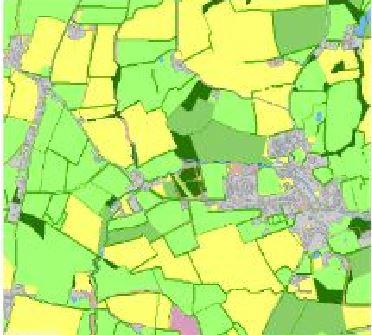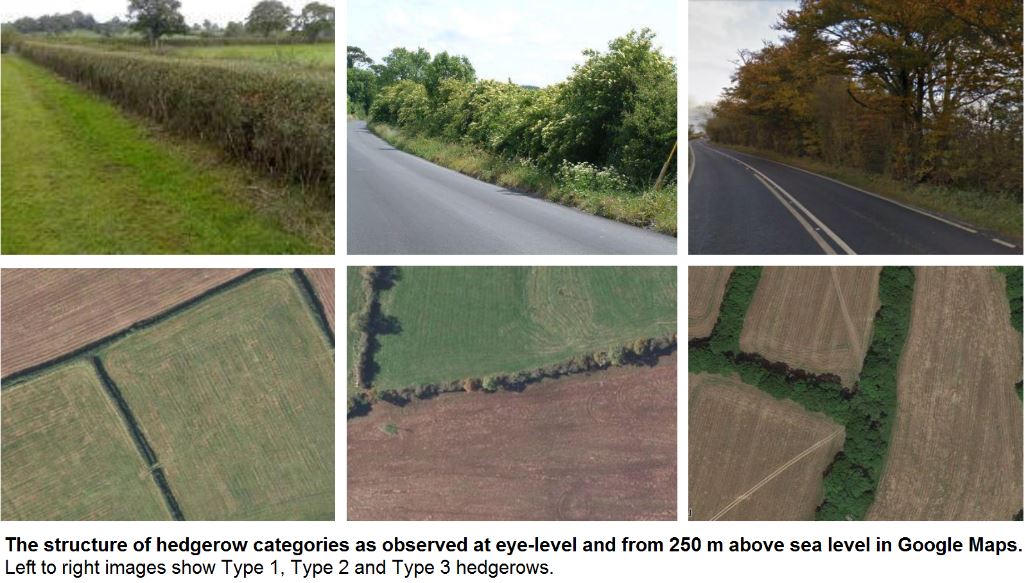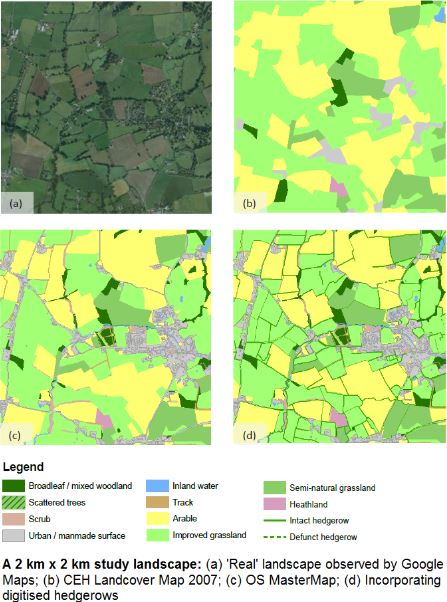
If you asked someone to describe the main elements that make up a typical British lowland landscape, you might expect the word ‘hedgerow’ to feature quite high up the list. Personally, the patchwork of green and brown fields, woodlands and small villages all connected and bordered by hedgerows and treelines is one of the first things I notice whenever I return home to the UK (particularly in the south where I work). From a research, policy and practice perspective, the ecological value provided by linear features are also pretty well recognised – whether as green corridors that facilitate (or impede) movement of species (and disease), buffer zones, cultural features or just habitat in their own right. They feature in site-based management plans, agri-environment schemes and implementation of ecological networks at the landscape scale.
Landscape composition and configuration
So you might be surprised to know back in 2010, when I embarked on my PhD (looking at the effects of landscape composition and configuration on woodland biodiversity) there were no spatial (GIS) datasets that took account of this amazing network. What we did have was an excellent Land Cover Map (LCM) from Centre for Ecology and Hydrology (LCM2007 at the time) and OS MasterMap Topography data (which detailed landscape features; water bodies, woodlands, field boundaries, paths, buildings etc…. just not hedgerows!). I was left with two choices: 1) complete my landscape analyses in the absence of hedgerow information; or 2) digitise the hedgerows myself.
Naturally, I chose the latter – whether this was a good decision depends on your perspective… drawing tens of thousands of kilometres of hedgerows sure did take a long time (we’re talking months) and I’m pretty sure some form of repetitive strain injury! However, the quality of research findings born out of the effort was well worth it. If you ask DEFRA nicely you may be able to use their new hedgerow dataset (read Keegan Wilson’s article on landscape features). If however, you prefer the ‘perfectionist’ approach to high-quality spatial hedgerow data, this is how I went about it:
Mapping hedgerows - a method
Back in 2008 I had the experience of surveying hedgerows (at a site-based scale) for the Hedgerow Inventory Project for the Sussex Biodiversity Records Centre (you can find out more at: http://sxbrc.org.uk/projects/hedgerows/). This highlighted the diverse nature of hedgerows – the different plant and tree species, their maturity, whether they were intensively managed or damaged, why some have ditches and/ or banks and the importance of the surrounding habitat. Naturally however, it was not going to be possible to survey every hedgerow in person across my 150 different 2 km x 2 km landscape sites from Berkshire to Dorset! I needed a quicker method that would ‘relatively quickly’ capture the key features:
Hedgerow type 1:
- low-lying, intensively managed (flailed) hedge;
- does not contain trees or woody elements;
- up to approximately 1.5 metres in height; and
- average width 2.5 metres.
Hedgerow type 2:
- hedge contains small/ juvenile trees or taller shrub-like species;
- less intensively managed than H1;
- greater than 1.5 metres in height; and
- average width 7 metres.
Hedgerow type 3
- hedge contains mature trees;
- appears structurally similar to a linear strip of broadleaved woodland when viewed from an aerial perspective; and
- average width 15 metres.
Hedgerow type 4:
- a line of trees (usually planted) which do not represent a hedge; and/or
- clear space between each tree or a defunct hedge (with gaps).
Image below showing hedgerow types 1-3
With reference to Google Maps, the location and type of each hedgerow was identified and digitised as a polyline layer in the GIS, using the OS MasterMap field boundaries and LCM2007 to guide the placement.
Image below showing data sources and precision: Aerial, LCM2007, OS Mastermap and finally digitised hedgerows.
The Results
This information allowed me to investigate in detail, the functions that hedgerows and tree lines provide for birds and insects in the lowlands of the UK. I found conclusive evidence that they provide refuge habitat for specialist insects following the destruction of semi-natural habitat in favour of intensive agriculture, they act as corridors for facilitating movement of woodland invertebrates through arable land and provide breeding, nesting and feeding habitat for many woodland birds [1, 2, 3].
I for one, look forward to seeing what new research might be born out of the UK’s ever-growing database of spatial data (to which we increasingly have access). Incidentally, if anyone is interested in access to my hedgerow data for their research, just drop me an email at publicity@iale.uk.
References
[1] Neumann, J.L., Holloway, G.J., Hoodless, A.N. & Griffiths, G.H. (2017) The legacy of 20th Century landscape change on today’s woodland carabid communities. Diversity and Distributions. DOI: 10.1111/ddi.12652.
[2] Neumann, J.L., Foster, C.W., Griffiths, G.H., Hoodless, A.N. & Holloway, G.J. (2016) The heterogeneity of wooded-agricultural landscape mosaics influences woodland bird community assemblages. Landscape Ecology. DOI:10.1007/s10980-016-0366-x.
[3] Neumann, J.L., Griffiths, G.H., Hoodless, A.N. & Holloway, G.J. (2015) The compositional and configurational heterogeneity of matrix habitats shape woodland carabid communities in wooded-agricultural landscapes. Landscape Ecology. DOI: 10.1007/s10980-015-0244-y.

